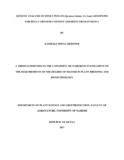Genetic analysis of sweet potato (ipomoea batatas (l) lam) genotypes for beta carotene content and root yield in Kenya.

View/
Date
2017Author
Kambale, Heritier M
Type
ThesisLanguage
enMetadata
Show full item recordAbstract
Vitamin A deficiency is a major challenge in most of the African countries including Kenya. Several strategies have been applied to fight this challenge, but the most effective strategy is the improvement of the available vitamin A intake by dietary diversity. This requires changing the eating habits as well as availing foods rich in vitamin A, or pro-vitamin A, such as orange fleshed sweet potato. The objectives of this study were: (i) to evaluate Kenyan sweet potato varieties for their agronomic performance as well as for their beta carotene content and (ii) to determine the inheritance of beta carotene and dry matter content in the F1 progenies.
Twenty five sweet potato genotypes were evaluated for agronomic performance, beta carotene and dry matter contents at KALRO-Kiboko and at Kabete field Station during the short rains season of July to November 2016, and during the long rains season of November 2016 to April 2017. The experiments were laid out in a randomized complete block design (RCBD) with three replications. Data on yield parameters and beta carotene and dry matter showed significant differences among genotypes at KALRO Kiboko as well as at Kabete. Genotype, Ininda and Naspot 12 recorded the higher fresh root yield of 89.90 and 24.06 t/ha at KALRO Kiboko and Kabete, respectively. Genotype, Naspot 13 had the highest beta carotene content across KALRO Kiboko and Kabete of 11.603 and 12.057 mg/100g, respectively. Genotype, Amelia provided the higher root dry matter content of 30.90 and 30.34 % at KALRO Kiboko and Kabete, respectively. The combined analysis of variance showed significant differences among genotypes, sites, seasons and interaction among genotypes and sites for yield and yield components.
Publisher
University of Nairobi
